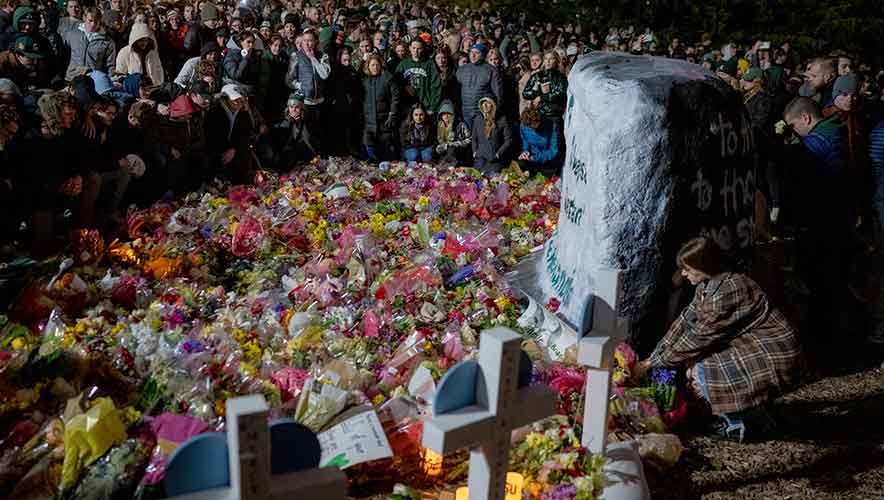In the Wake of More Mass Shootings, Americans' Dissatisfaction with Gun Laws Reaches New High
Two mass shootings in the United States highlight this year’s high rate of gun violence. On Monday night, a shooter attacking Michigan State University left three students dead and five people injured, while an incident on Wednesday night at a mall in El Paso, Texas, resulted in one death and three more wounded.
At 8:31 p.m. local time, Michigan State University sent its students and staff an alert. “Run, hide, fight,” it said, along with information that there was a report of shots fired on the university’s East Lansing campus.
The shooter, who does not appear to have been affiliated with the school, opened fire at 8:18 p.m. at Berkey Hall—killing two students—and then conducted another attack at the popular and multiuse facility, the MSU Union, where he killed another person. The three students who were killed were Arielle Anderson, a junior hoping to become a surgeon; Brian Fraser, a sophomore and president of the university’s Phi Delta Theta fraternity; and Alexandria Verner, a junior studying integrated biology and anthropology.
Five more were injured, and as of 16 February, one has stabilized and four remain in critical condition, MSU Police said on Twitter.
The motive of the alleged shooter, Anthony McRae, 43, remains unknown. McRae’s father told NBC News that after McRae’s mother died in 2020, the shooter quit his job and became “bitter,” withdrawn, and “he just started getting evil and mean.” Since Monday, law enforcement have said that McRae suffered from “mental health issues,” according to The Washington Post.
McRae evaded police after the shooting until law enforcement officials confronted him in Lansing, Michigan, following a tip. McRae, after speaking with police, killed himself with a self-inflicted gunshot.
In 2019, McRae was charged with a felony—carrying a concealed weapon—and a misdemeanor—possession of a loaded firearm in or upon a vehicle. McRae pled guilty—with the charges reduced to a misdemeanor—was sentenced to probation, and was discharged in May 2021. “If he had been convicted of the felony, he would have been barred from legally owning a gun, according to a Michigan county prosecutor,” the Post said.
Neighbors claim they heard gun shots coming from the McRaes’ backyard, however, McRae claimed the sounds were fireworks.
After the Michigan State University shooting, there were “67 mass shootings in 2023 in the United States, more than any other year when compared with the same period,” according to the Post. “The toll is immense. Less than two months into 2023, mass shootings have already killed 104 people and injured 269 this year in America.”
Adding to that toll were the four men who were shot in the food court of the Cielo Vista Mall in El Paso, Texas, on 15 February. While one of the men shot was announced as dead at the scene, the three other men wounded in the attack were hospitalized nearby at University Medical Center and Del Sol Medical Center.
Two suspects were taken into custody after the shooting at the Texas mall, according to news reports.
“Interim police Chief Peter Pacillas said the gunman was taken down quickly by an off-duty police officer who was working security at a store in the mall,” The El Paso Times reported.
Law enforcement reported that calls about the shooting were logged at 5:05 p.m., local time. The suspect was subdued by an off-duty officer within three minutes. Along with the security officer, other law enforcement units—including the county’s sheriff’s office, a SWAT team, the FBI, Texas Department of Public Safety, and U.S. Border Patrol—responded to the attack.
The FBI created a virtual tip site for any witnesses who recorded aspects of the shooting.
The motive for the shooting remains unknown to law enforcement, according to Fox News. “The police chief did not provide details on how the second suspect was apprehended, and no names, ages, or descriptions of the victims or suspects were immediately released,” CBS News reported.
Across the parking lot from the mall is the Walmart where a shooter opened fire in 2019, deliberately targeting Hispanic people. Last week, the gunman in the 2019 attack—which left 23 people dead—“pleaded guilty to federal hate crime and firearms charges,” according to CBS News.
As part of a plea deal, gunman Patrick Crusius, 24, accepted 90 consecutive life sentences, one for each of the charges, and waived most of his rights to appeal, according to the Associated Press (AP). Although a sentencing hearing will not convene until later in 2023, the U.S. government announced it would not seek the death penalty against Crusius.
“Crusius had originally pleaded not guilty before federal prosecutors took the death penalty off the table. He could still receive the death penalty, however, under separate state capital murder charges in Texas, although it remains unclear when that case might go to trial,” the AP reported.
Last year, there were more than 600 mass shootings in the United States, the AP said, citing data from the Gun Violence Archive (GVA). A mass shooting is defined as an incident of gun violence where at least four people were killed or wounded.
The GVA, which logs and categorizes instances of gun violence in the United States, noted that as of 16 February, there have been 72 mass shootings in 2023—a little more than 1.5 mass shootings every day.
After the shooting at Michigan State, U.S. President Joe Biden echoed a familiar plea to legislators: to end gun violence with gun law reform and a call for a ban on assault-style weapons, the Post reported.
“Americans’ dissatisfaction with U.S. gun laws has risen to 63 percent, the highest by one percentage point in Gallup’s 23-year trend, and an increase of seven points over the past year. At the same time, satisfaction with gun policy has fallen by the same amount to 34 percent, tying the lowest reading on record,” Gallup reported, hours before the Cielo Vista Mall shooting. The poll was conducted in January.
While frustration over gun violence in the United States in 2022 generated support for significant federal gun legislation—people considered a threat to public safety are prohibited from owning a firearm—there are other indications that this may not be sufficiently protecting the public.
The U.S. Bureau of Alcohol, Tobacco, Firearms, and Explosives (ATF) reported in early February that stolen guns, untraceable weapons, and other deadly devices are increasingly playing a role in U.S. gun crimes. The report—the like of which has not been published for 20 years—provides data from 2017 to 2021 about guns used in crimes, illustrating the scope of stolen weapons and gun trafficking, according to NPR.
The ATF found that there were a few ways that legally purchased firearms might later fall into the hands of criminals or others prohibited from purchasing a gun. In the report, National Firearms Commerce and Trafficking Assessment: Crime Guns (Volume Two), the bureau noted that “54 percent of traced crime guns were recovered by law enforcement more than three years after their purchase, while nearly 46 percent were recovered less than three years after their purchase.”
Along with a boom in private sales in 2020 and 2021, more than one million firearms were reported stolen from private citizens between 2017 and 2021. That statistic does not include the thefts that went unreported.
Another significant issue in tracking firearms used in crimes are ghost guns—privately manufactured firearms. “Law enforcement agencies recovered and submitted 37,980 suspected privately made firearms (PMFs) to ATF for tracing between 2017 and 2021,” the report said. “It is probable that current trace data significantly underrepresents the number of PMFs recovered in crimes.” The report also noted an increase in the use of ghost guns used in crimes within that same time.
“There have been recent attempts to curtail the prevalence of these weapons. Last year, the ATF finalized a rule that would bring the regulation of ghost guns in line with traditional guns,” NPR said.











